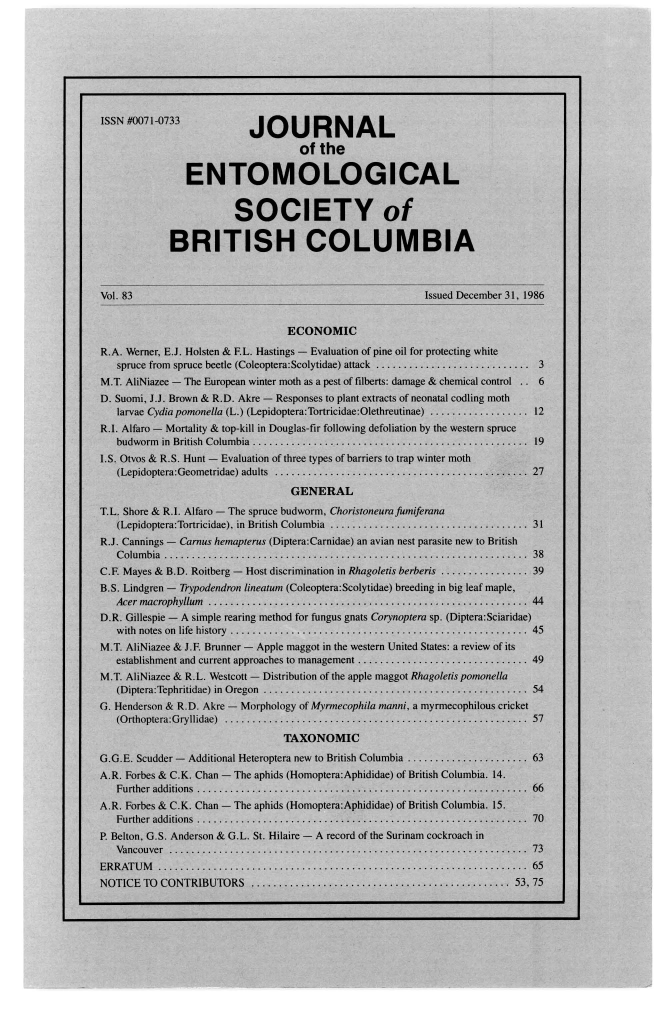Evaluation of three types of barriers to trap winter moth (Lepidoptera: Geometridae) adults
Keywords:
winter moth, Lepidoptera, GeometridaeAbstract
Three types of barrier traps, Tanglefoot®, fiberglass and fiberglass sprayed with the insecticide Raid®, were tested at three locations, on eight trees each per treatment and location for a total of 72 trees, to determine their efficiency in preventing the flightless winter moth females from crawling higher up the tree to oviposit. The efficiency of the barrier was evaluated by counting the number of female winter moth adults caught 10-15 cm above the test barrier. Tanglefoot® was the most effective barrier. An average of 67.1 winter moth females managed to crawl over the fiberglass barrier compared to 3.6 females over the fiberglass barrier sprayed with Raid® and 1.1 females over the Tanglefoot® barrier. The differences among the average catches were significant (P<0.01) for the fiberglass barrier but not between the fiberglass barrier with Raid® and the Tanglefoot® barrier. We recommend that Tanglefoot® applied over a polyethylene strip, after the bark crevices have been plugged, be used to prevent winter moth females from crawling under the barrier. The Tanglefoot® barrier has the added advantages that it is cheap, non-toxic and, since it reduces or eliminates the need for insecticide application, it is fully compatible with biological control measures.References
Gillespie, D.R., T. Finlayson, N.V. Tonks, and D.H. Ross. 1978. Occurrence of the winter moth, Operophtera brumata (Lepidoptera: Geometridae), on southern Vancouver Island, British Columbia. Can. Ent. 110:223-224.
Graham, A.R. 1958. Recoveries of introduced species of parasites of the winter moth, Operophtera brumata (L.) (Lepidoptera: Geometridae), in Nova Scotia. Can. Ent. 90:595-596.
Ebree, D.G. 1966. The role of introduced parasites in the control of the winter moth in Nova Scotia. Can. Ent. 98:1159-1168.
Embree, D.G. and I.S. Otvos. 1984. Operophtera brumata (L.), winter moth (Lepidoptera: Geometridae). Ch. 61 (pp. 353-357). In: J.S. Kelleher and M.A. Hulme (eds.). Biological Control Programmes Against Insects and Weeds in Canada 1969-1980. Commonwealth Agricultural Bureaux, Farnham Royal, England.
Puritch, G.S. and S.F. Condrashoff. 1985. Insecticide mixture containing fatty acids. Canadian patent no. 1187409.
Tonks, N.V., P.R. Everson, and T.L. Theaker. 1978. Efficacy of insecticides against geometrid larvae, Operophtera spp., on southern Vancouver Island, British Columbia. J. Entomol. Soc. Brit. Columbia 75:6-9.
Zar, J.H. 1974. Biostatistical analysis. Prentice-Hall, Englewood Cliffs, N.J. 620 pp.
Downloads
Published
Issue
Section
License
Authors who publish with the Journal of the Entomological Society of British Columbia agree to the following terms:
-Authors retain copyright and grant the journal right of first publication with the work simultaneously licensed under a Creative Commons Attribution License that allows others to share the work with an acknowledgement of the work's authorship and initial publication in this journal.
-Authors are able to enter into separate, additional contractual arrangements for the non-exclusive distribution of the journal's published version of the work (e.g., post it to an institutional repository or publish it in a book), with an acknowledgement of its initial publication in this journal.
-Authors are permitted and encouraged to post their work online (e.g., in institutional repositories or on their website) prior to and during the submission process, as it can lead to productive exchanges, as well as earlier and greater citation of published work (See The Effect of Open Access).


